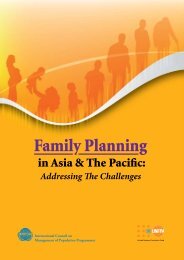Inter-lInkages between PoPulatIon DynamIcs anD DeveloPment In ...
Inter-lInkages between PoPulatIon DynamIcs anD DeveloPment In ...
Inter-lInkages between PoPulatIon DynamIcs anD DeveloPment In ...
Create successful ePaper yourself
Turn your PDF publications into a flip-book with our unique Google optimized e-Paper software.
Special Attention to YouthYouth (15-24 years old) need special attention not only to utilise potential demographic dividend, but also toaddress the population momentum and greater vulnerability to HIV/AIDS. Nearly a sixth of the TFR isaccounted for by adolescents aged <strong>between</strong> 15-19 years and nearly 16% in this age group had begunchildbearing. About 13% of the currently married adolescent women are using contraception. However, theunmet need for birth spacing of married women in the age groups of 15-19 years and 20-24 years are veryhigh, 25.1% and 14.9% respectively. Recent surveys on the situation and needs of youth in <strong>In</strong>dia shows thatin two states - Rajasthan and Bihar - about 18% of married males <strong>between</strong> age 15-29 years ever hadpremarital sex and about 8-10% of unmarried males age 15-24 years had premarital sex.UNFPA, in partnership with the World Health Organization (WHO), has helped the Government of <strong>In</strong>dia vastlyexpand its services to young people by providing strategic, technical and operational guidance to the MOHFWin the integration of adolescent-friendly service centres into the PHC infrastructure in 75 districts. Severalprojects by NGOs have also shown that it is possible to delay first child. However, a large group of youngpeople remain unreached by RH services. There is a clear need for the NRHM to address the FP/RH needs ofthe youth.Migrants and HIV PreventionThere are over 200 million migrants in <strong>In</strong>dia. The Census 2001 data indicates that during 1991-2001,about 61% migrants moved within the districts, 24% within the states and 13% inter-state. Also, threemillion <strong>In</strong>dian migrants live in Gulf countries. However, not all migrants are at equal risk of HIV. The 8.64million temporary, short duration migrants are of special significance to the epidemic because of their frequentmovement <strong>between</strong> source and destination areas. <strong>In</strong> the existing pattern of concentrated epidemics withpockets of high prevalence, movement of people in the absence of migrant-friendly services can result in therapid spread of the HIV infection.The NACP III includes initiatives that address the unique needs of migrants to avert a potential rise of HIVinfection among migrant populations. These include:• Mainstreaming HIV/AIDS interventions with poverty alleviation schemes as many migrants move in searchof livelihood;• Supplementing the interventions that mostly concentrate on migrant workers at destination locations withthose at the source points based on careful mapping of source and destination states. Successful examplesof source-destination pilot initiatives demonstrate the importance of promoting volunteerism, workingthrough peers and engaging a range of partners at source and destination sites to reach out to migrantsand their families;• <strong>In</strong>tegrating HIV/AIDS in the welfare programmes of companies that employ migrant/contractual workers;• Focusing on short-term migrants through identifying, training and encouraging volunteers to disseminatepreventive messages among their fellow workers; and• <strong>In</strong>troducing HIV/AIDS modules in the pre-departure training programmes for overseas migrants of theMinistry of Labour and orientation programme for Embassy staff of the Ministry of External Affairs.WaterAvailability and distribution of rainfall will depend upon the effect of climate change. However, a particularlypowerful impact of population growth is likely to be on future demand for water because of the strong link<strong>between</strong> food demand and population size, and the fact that agriculture takes a very large share of <strong>In</strong>dia’swater supplies. The effect of population growth suggests that considerable improvements will be needed inthe efficiency of water use as agriculture, manufacturing, and services sectors will all need increased amountof water. Generally, the consensus of studies in this area is that the situation will be difficult, and localisedwater problems may intensify, but there need not be a crisis for <strong>In</strong>dia as a whole if the right supply anddemand side measures are adopted in time.The measures suggested for the Eleventh Plan address the whole range of issues concerning water managementand irrigation, including reducing the gestation period of projects, rainwater harvesting, watershed development,water resources conservation, and flood management.36














